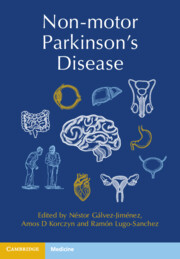Book contents
- Non-Motor Parkinson’s Disease
- Non-Motor Parkinson’s Disease
- Copyright page
- Contents
- Contributors
- Introduction
- Chapter 1 Parkinson’s Disease: An Overview of the Non-Motor Symptomatology
- Chapter 2 Evaluation of the Patient with Parkinson’s Disease in the Early Stages: Non-Motor Phase
- Chapter 3 Non-Motor Symptoms in Late-Stage Parkinson’s Disease
- Chapter 4 Neuropathology of Non-Motor Parkinson’s Disease Symptoms
- Chapter 5 Neuroimaging Studies in Non-Motor Parkinson’s Disease Symptoms
- Chapter 6 Mild Cognitive Impairment
- Chapter 7 Cognitive Dysfunction in Parkinson’s Disease
- Chapter 8 Neuropsychiatric (Behavioral) Symptoms in Parkinson’s Disease
- Chapter 9 Mood Disorders in Parkinson’s Disease
- Chapter 10 Olfactory Dysfunction in Parkinson’s Disease and Related Disorders
- Chapter 11 Oculomotor and Visual-Vestibular Disturbances in Parkinson’s Disease
- Chapter 12 Autonomic Dysfunction and Failure in Parkinson’s Disease
- Chapter 13 Gastrointestinal Disturbances in Parkinson’s Disease Including the Management of Sialorrhea
- Chapter 14 Sexual Dysfunction in Parkinson’s Disease
- Chapter 15 Sleep Disturbances in Parkinson’s Disease
- Chapter 16 Musculoskeletal Disorders and Pain in Parkinson’s Disease
- Chapter 17 Cutaneous Manifestations of Parkinson’s Disease
- Chapter 18 Genetics of Non-Motor Symptoms of Parkinson’s Disease
- Chapter 19 Drug-Induced Non-Motor Symptoms in Parkinson’s Disease
- Chapter 20 Impulse Control Disorders and the Dopamine Dysregulation Syndrome
- Chapter 21 Serotonin Syndrome and Drug Interactions, Hypertensive Complications, and, Adverse Effects of Monoamine Oxidase Inhibitors in Patients with Parkinson’s Disease
- Chapter 22 Parkinson’s Disease and Pregnancy
- Index
- Plate Section (PDF Only)
- References
Chapter 11 - Oculomotor and Visual-Vestibular Disturbances in Parkinson’s Disease
Published online by Cambridge University Press: 05 March 2022
- Non-Motor Parkinson’s Disease
- Non-Motor Parkinson’s Disease
- Copyright page
- Contents
- Contributors
- Introduction
- Chapter 1 Parkinson’s Disease: An Overview of the Non-Motor Symptomatology
- Chapter 2 Evaluation of the Patient with Parkinson’s Disease in the Early Stages: Non-Motor Phase
- Chapter 3 Non-Motor Symptoms in Late-Stage Parkinson’s Disease
- Chapter 4 Neuropathology of Non-Motor Parkinson’s Disease Symptoms
- Chapter 5 Neuroimaging Studies in Non-Motor Parkinson’s Disease Symptoms
- Chapter 6 Mild Cognitive Impairment
- Chapter 7 Cognitive Dysfunction in Parkinson’s Disease
- Chapter 8 Neuropsychiatric (Behavioral) Symptoms in Parkinson’s Disease
- Chapter 9 Mood Disorders in Parkinson’s Disease
- Chapter 10 Olfactory Dysfunction in Parkinson’s Disease and Related Disorders
- Chapter 11 Oculomotor and Visual-Vestibular Disturbances in Parkinson’s Disease
- Chapter 12 Autonomic Dysfunction and Failure in Parkinson’s Disease
- Chapter 13 Gastrointestinal Disturbances in Parkinson’s Disease Including the Management of Sialorrhea
- Chapter 14 Sexual Dysfunction in Parkinson’s Disease
- Chapter 15 Sleep Disturbances in Parkinson’s Disease
- Chapter 16 Musculoskeletal Disorders and Pain in Parkinson’s Disease
- Chapter 17 Cutaneous Manifestations of Parkinson’s Disease
- Chapter 18 Genetics of Non-Motor Symptoms of Parkinson’s Disease
- Chapter 19 Drug-Induced Non-Motor Symptoms in Parkinson’s Disease
- Chapter 20 Impulse Control Disorders and the Dopamine Dysregulation Syndrome
- Chapter 21 Serotonin Syndrome and Drug Interactions, Hypertensive Complications, and, Adverse Effects of Monoamine Oxidase Inhibitors in Patients with Parkinson’s Disease
- Chapter 22 Parkinson’s Disease and Pregnancy
- Index
- Plate Section (PDF Only)
- References
Summary
In this chapter we will describe how Parkinson’s disease (PD) affects patients’ eye movements, both bedside and laboratory, preceded by brief review of the anatomo-physiological substrate of eye movements. We will provide a practical summary of how to use the eye movement examination to aid the differential diagnosis of the parkinsonian syndromes, in particular idiopathic PD from multiple system atrophy (MSA), progressive supranuclear palsy (PSP), and corticobasal syndrome (CBS). A sub-section will describe how deep brain stimulation (DBS) also influences eye movements in PD. Despite a plethora of eye movement laboratory studies in PD it is still relatively unknown what the eye movements of these patients are like in real life. Given that the eyes move in order to see better, does the akinesia of PD impose visual deprivation or delays during ecological whole-body movements?.
- Type
- Chapter
- Information
- Non-motor Parkinson's Disease , pp. 115 - 129Publisher: Cambridge University PressPrint publication year: 2022
References
- 1
- Cited by



